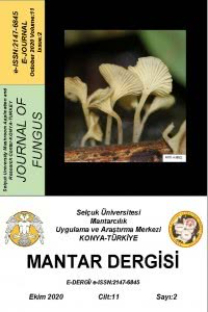Tricholoma anatolicum ve Tricholoma caligatum’un Morfolojik ve Moleküler Yönden Karşılaştırılması
ISSR, Morfoloji, Tricholoma, Türkiye
The Comparison of Tricholoma anatolicum and Tricholoma caligatum Species by Morphological and Molecular Methods
ISSR, Morphology, Tricholoma, Turkey,
___
- Allı, H. and Şen İ. (2016). Tricholoma Türlerinin Yenilebilirliği Üzerine Notlar. Türk Tarım – Gıda Bilim ve Teknoloji Dergisi, 4(3): 178-181.Anderson, I. C., Chambers, S. M. and Cairney, J.W. G. (2001). Distribution and persistence of Australian Pisolithus species genets at native sclerophyll forest field sites. Mycol Res, 105: 971–976.Amend, A., Garbelotto, M., Fang, Z. and Keeley, S. (2010). Isolation by landscape in populations of a prized edible mushroom Tricholoma matsutake. Conserv Genet, 11: 795–802.Amicucci, A., Zambonelli, A., Guidi, C. and Stocchi, V. (2001). Morphological and molecular characterisation of Pulvinula constellatio ectomycorrhizae. FEMS Microbiology Letters 194: 121-125.Bao, D., Koike, A., Yao, F., Yamanaka, K., Aimi, T. and Kitamoto, Y. (2007). Analyses of the genetic diversity of matsutake isolates collected from different ecological environments in Asia. J Wood Sci 53: 344–350.Bergius, N., Danell, E. (2000). The Swedish matsutake (Tricholoma nauseosum syn. T. matsutake): distribution, abundance and ecology. Scand J For Res, 15: 318–325.Bessette, E. A., Bessette, A. R., Roody, W.C., Trudell, S. A. (2013). Tricholomas of North America, A Mushroom Field Guide. Austin. University of Texas Press.Boa, E. (2004). Wild edible fungi, a global overview of their use and importance to people. Rome, Non Wood Forest Products 17. FAO.Chapela, I. H. and Garbelotto, M. (2004). Phylogeography and evolution in matsutake and close allies inferred by analyses of ITS sequences and AFLPs. Mycologia 96: 730–741.Christensen, M. and Heilmann-Clausen, J. (2013). The genus Tricholoma, Fungi of Northern Europe, Vol 4. Denmark. Narayana Press.Cullings, K.W. (1992). Design and testing of a plant-specific PCR primer for ecological and evolutionary studies. Molecular Ecology, 1: 233–240.Doğan H. H. and Akata I. (2011). Ecological features of Tricholoma anatolicum in Turkey. African Journal of Biotechnology, 10 (59): 12626-12668.Doyle, J. J. and Doyle J. L. (1987). A rapid DNA isolation procedure for small quantities of fresh leaf tissue. Phytochemical Bulletin, Botanical Society of America, 19: 11–15.Galli R. (1999). I Tricholomi. Milano. Dalla Natura.Gherbi, H., Delaruelle, C., Selosse, M.A. and Martin, F. (1999). High genetic diversity in a population of the ectomycorrhizal basidiomycete Laccaria amethystina in a 150-year-old beech forest. Mol Ecol, 8: 2003–2013.Horton, T.R. and Bruns, T.D. (2001). The molecular revolution in ectomycorrhizal ecology: peeking into the black-box. Molecular Ecology 10: 1855-1871.Intini, M., Dogan, H. H. and Riva, A. (2003). Tricholoma anatolicum spec. nov.: un nuovo membro del gruppo matsutake. Micol Veg Mediterr, 18:135–142.Kalmış, E., Eltem R., Işıloğlu, M., Solak, M. H., Kalyoncu, F. ve Gezgin, Y., 2009, Muğla ilindeki Tricholoma caligatum populasyonlarının belirlenmesi ile İnvitro da kültürel özelliklerinin açığa çıkarılması. TÜBİTAK Projesi Ege Üniversitesi Fen Bilimleri Enstitüsü (Tübitak-TBAG, 105T128), İzmir.Kaya, A., Uzun, Y. ve Karacan, İ. H. (2009). Göksun (Kahramanmaraş) Yöresi Makrofungusları. Türk J. Bot, 33: 131-139.Lim, S. R., Fischer, A., Berbee, M. and Berch, S. M. (2003). Is the booted Tricholoma in British Columbia really Japanese matsutake? BC J Ecosyst Manage, 3:1–7.Matsushita, N., Kikuchi, K., Sasaki, Y., Guerin-Laguette, A., Lapeyrie, F., Vaario, L-M., Intini, M. and Suzuki, K. (2005). Genetic relationship of Tricholoma matsutake and T.nauseosum from the northern hemisphere based on analyses of ribosomal DNA spacer regions. Mycoscience 46: 90–96.Ota, Y., Yamanaka, T., Murata, H., Neda, H., Ohta, A., Kawai, M., Yamada, A., Konno, M. and Tanaka, C. (2012). Phylogenetic relationship and species delimitation of matsutake and allied species based on multilocus phylogeny and haplotype analyses. Mycologia, 104 (6): 1369–1380. Riva, A. (2003). Tricholoma (Fr.) Staude Supplemento, Fungi Europaei. Italia. Candusso.Rohlf, F. J. (1998). NTSYSpc numerical taxonomy and multivariate analysis system user guide, Exeter Software, New York, 0-925031-28-3.Sawyer, N.A. and Chambers, S. M. and Cairney, J. W. G. (2001). Distribution and persistence of Amanita muscaria genotypes in Australian Pinus radiata plantations. Mycol Res, 105: 966–970.Soltis, D.E., Collõer, T.G., Edgerton, M.L. 1991. The Heuchera group (Saxifragaceae): Evidence for chloroplast transfer and paraphyly. Amer J Bot, 78: 1091–1112.Taşkın H., Eker T., Bozok F., Doğan H.H., Büyükalaca S. (2018). Determination of Multiple Antioxidant Activities of Endemic Tricholoma anatolicum H.H Doğan & Intini Collected from Turkey. Turkish Journal of Agriculture - Food Science and Technology, 6(11): 1582–1585. Xu, J., Sha, T., Li, Y. C., Zhao, Z. W. and Yang, Z. L. (2008). Recombination and genetic differentiation among natural populations of the ectomycorrhizal mushroom Tricholoma matsutake from southwestern China. Mol Ecol, 17: 1238–1247.Wan, J., Koike, A., Yamanaka, K., Sotome, K., Morinaga, T., Tanaka, C., Terashima, Y. and Aimi T. (2012). Genetic diversity of Tricholoma matsutake and close allies associated with broad- leaved trees in Asia. Mushroom Sci Biotechol 19: 167–174.Zhou, Z., Miwa, M., Hogetsu, T. (1999). Analysis of genetic structure of a Suillus grevillei population in a Larix kaempferi stand by polymorphism of inter-simple sequence repeat (ISSR). New Phytol, 144: 55–63.Zhou, Z., Miwa M., Hogetsu, T. (2000). Genet distribution of ectomycorrhizal fungus Suillus grevillei populations in two Larix kaempferi stands over two years. J Plant Res, 113: 365–374.Zietkiewicz, E., Rafalski, A., Labuda, D. (1994). Genome fingerprinting by simple sequence repeat (SSR)-anchored polymerase chain reaction amplification. Genomics, 20: 176-183.
- ISSN: 2147-6845
- Yayın Aralığı: Yılda 2 Sayı
- Başlangıç: 2010
- Yayıncı: Selçuk Üniversitesi Mantarcılık Uygulama ve Araştırma Merkezi Müdürlüğü
Küresel Gıda Güvenliği Riski: Ug99 Kara Pas Irkı
Yenebilir ve Tıbbi Mantarların Gıda Ürünlerinde Kullanım Potansiyeli
Sanem BULAM, Aysun PEKŞEN, Nebahat Şule ÜSTÜN
Butyriboletus fuscoroseus; Türkiye Mikotası için Yeni Bir Boletoid Makrofungus Kaydı
Hakan ALLİ, İsmail ŞEN, Roni Aran ADIBELLİ
Fuat BOZOK, Boris ASSYOV, Hatıra TAŞKIN, Saadet BÜYÜKALACA
Tanay UZGAN, Yiğit TERZİ, Füsun Bahriye UÇAR
Eskişehir İli Tarım Topraklarındaki Isıya Dirençli Toprak Mikrofunguslarının Biyoçeşitliliği
Fatma AYVA, Goulsoum OUZEİR, Rasime DEMİREL, Burhan ŞEN, Ahmet ASAN, Duygu KADAİFÇİLER
Tarım Topraklarındaki Isıya Dirençli Fungusların Belirlenmesi Üzerine Ön Çalışma
Fatih BAYDAŞ, Ebubekir ALTUNTAŞ
Nezahat Gökyiğit Botanik Bahçesi'nin Mikrofungusları I.: Yeni Familya ve Tür Kayıtları
